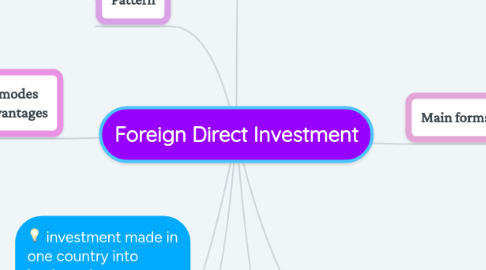Foreign Direct Investment
by Choong Chang Hong


1. Eclectic paradigm
1.1. location-specific advantages
1.2. begin to exploit resources
2. Vernon's product life-cycle theory
2.1. initiation of FDI
2.2. particular stages
2.2.1. I. Introduction
2.2.2. II. Growth
2.2.3. III. Maturity or Stabilization
2.2.4. IV. Decline
3. Knickerbocker's theory
3.1. imitative behavior
4. Pattern
5. Exporting
5.1. transportation cost
5.2. trade barriers
6. Entry modes disadvantages
7. Licensing
7.1. drawbacks
7.2. market imperfections
8. investment made in one country into business interests located in another country
9. Government Policy Instrument
10. Home countries
10.1. polices to encourage and restrict FDI
11. Host countries
11.1. attract FDI
11.1.1. by offering incentives
11.2. try to restrict FDI
11.2.1. by dictating ownership
12. Host countries
12.1. Resource transfer effects
12.2. Employment effects
12.3. Balance of payments effects
12.4. Competition
12.5. Adverse enffects on payment
12.6. Loss of national sovereignty
13. Benefits and Costs
14. Home countries
14.1. Improvement in the balance of payments
14.2. Positive employment effects
14.3. Benefits from a reverse effect
14.4. Adverse balance of payments
14.5. Costs
15. Greenfield investment
15.1. new operation
16. Main forms
17. incorporate with an existing company in a foreing country
18. Flow
18.1. outflows
18.2. inflows
19. World Economy
20. Stock
21. Political idiology
22. Radical view
22.1. Marxist theory
22.2. MNE as instrument of imperialist
23. Free Market View
23.1. classical economics
23.2. international trade theories
23.3. distribution among countries
23.4. theory of comparative advantage
24. Pragmatic Nationalism
24.1. benefit a host country
24.2. foreign rather than domestic
24.2.1. profits go abroad
